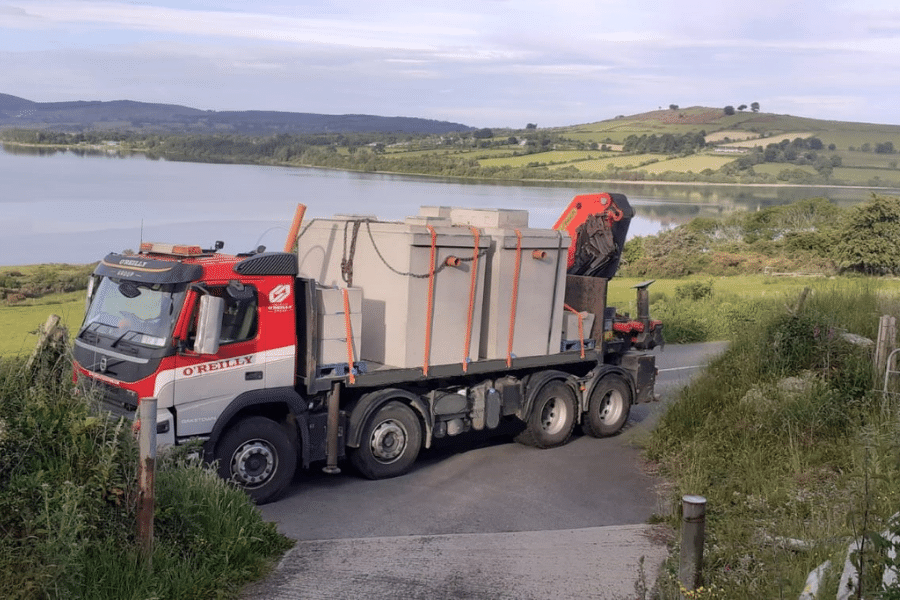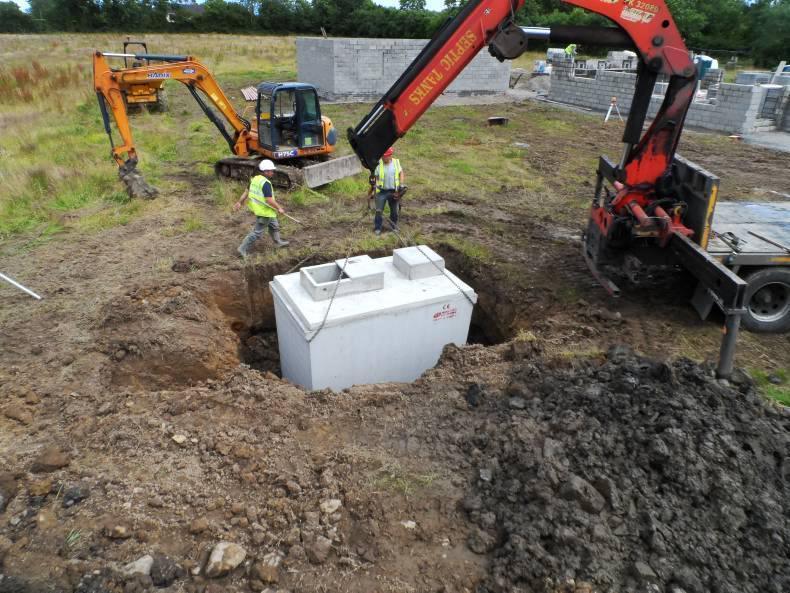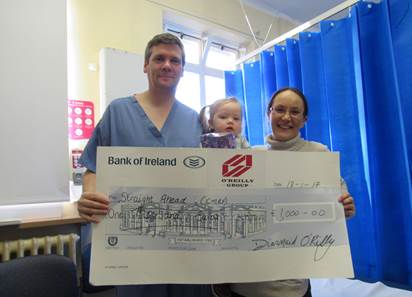What is the Cost of Installing New Sewage Treatment Systems?
The cost of a Oakstown sewage, or wastewater treatment system, depends on which system you require. Oakstown Environmental manufacture both pumped and gravity discharge systems.
We can supply a 6PE Sewage Treatment System, ideal for most domestic homes, including pump.
We also supply a larger 8PE Sewage treatment System, see more here.
Our PE6 system is supplied with concrete risers to maximum height of 900mm, up to 50 meters of 7 core SWA cable, control panel, air blower, water pump (depending on system) and a two-year guarantee on all components.
Cost of Installing a new Septic Tank
If you wish to install a new septic tank read more here.
Why use a sewage treatment system/wastewater treatment system and not a septic tank?
The Oakstown wastewater treatment system provides treatment of all wastewater from the dwelling, whereas a septic tank simply separates it.
This means that the wastewater that leaves the treatment system is cleaner than what leaves a septic tank and it’s certainly a lot more environmentally friendly.
What maintenance is involved in a BAF Sewage Treatment System?
The Oakstown BAF wastewater treatment system should be desludged every 3 to 5 years depending on usage and serviced every 12 months.
When our technicians call out to service a system they will spend on average 45-75 minutes on site, completing a full digital service report for your system.
Some of the checks made are Forward blower pressure, Back pressure of the Air system, Dissolved Oxygen reading of treatment chamber, PH level of water in discharge chamber, all electrical items tested or repaired.
All alarms on system checked for operation. Details of any issues or need for desludging reported to customer.

— Original Article —
O’Reilly Oakstown Environmental talks about the cost of installing new sewage treatment systems
After flooding a few years ago in 2016, it has become apparent that many septic tanks in rural areas are not working efficiently and may need upgrading. A septic tank is traditionally used for the primary treatment of sewage from most rural houses. Many older houses will only have a septic tank and some form of percolation area for sewage treatment but this is not always sufficient for treating sewage.
“In the septic tank the sludge settles, while the crust floats and the liquid or grey water moves on to the percolation area. Over 99.5% of all solids should be retained in the tank,” explained Diarmuid of O’Reilly Oakstown.
Sewage treatment takes place here via anaerobic digestion, generally breaking down the effluent by 30%. Typically, in older systems the grey water (partially treated sewage) goes to the percolation area where the soil is expected to do the remaining 70% of sewage treatment.
How the system should work
Many Irish soils are unsuitable to carry out this level of sewage treatment and secondary treatment is usually required.
A secondary treatment system takes the partially digested water and feeds it to bacteria that break it down further.
There are many different types of secondary sewage treatment systems.
In Oakstown we use a three-chamber secondary treatment process to digest, clarify and then pump the water from the two primary chambers. In the bioreactors aerobic bacteria are cultured on durable netted plastic biomedia. This gives the microbes adequate surface to attach to while air is blown through the tubes from a low-watt blower sitting on top of the tank.
The air enters the tubes from the bottom of the tank and diffuses into millions of tiny bubbles, allowing the aerobic bacteria to thrive.
The inclusion of both air and grey water activates the bacteria to work on further breaking down the sewage via aerobic digestion, and making it less harmful to the environment.
The second chamber acts as a clarifier to periodically remove any solids which may get to that stage. The final chamber is the discharge area. Here a water pump moves treated sewage from the system to the percolation area. Up 99% of the sewage treatment efficiency can be achieved after it goes through the combination of primary and secondary treatment.
Repairing an existing system
The main signs that a sewage treatment system is not functioning properly is water backing up in sewers and ponding around the percolation area. Sometimes it may be possible to fix a tank by fixing the T-bend where the waste enters the primary tank.
A properly functioning T-bend slows down the rate of movement of solids into the tank, reducing the splash effect in the tank so that a scum layer can form creating anaerobic conditions for waste water treatment.
Baby wipes should never be let into a tank because they cannot be broken down and cause blockages.
However, many old sewage treatment systems are beyond repair and are not fit for purpose. Some older tanks have structural cracks or the percolation system no longer works efficiently. Diarmuid believes these systems should be upgraded. Certainly, both septic tanks and sewage treatment systems should be desludged regularly.
Installing a new system
Planning permission is required when installing a new system but this is on the basis of a report from a soil engineer who will assess the site and recommend what type of treatment system is necessary.
A site assessment will determine whether or not a particular site can achieve the safe dispersal of wastewater from a development. Diarmuid says soil engineers carry out T-tests and P-tests. Very good soils that are efficient at treating grey water in a percolation area will typically have a T-test result of five to 20.
Extremely free-draining soils with a T-test result under five would likely require a secondary treatment system because partially treated sewage may make its way directly into groundwater or wells too easily.
On the other hand, wetter soils with a T-test over 20 would also be more likely to require secondary sewage treatment because in time there may be a risk of clogging in average to poor soils.

Cost of Installing New Sewage Treatment Systems
The cost of installing new sewage treatment systems depends on which system you require. Oakstown Environmental manufacturer both pumped and gravity discharge systems.
Contact us here and we will get back to you as son as possible with a cost.
Our PE6 system is supplied with concrete risers to maximum height of 900mm, up to 50 meters of 7 core SWA cable, control panel, air blower, water pump (depending on system) and a two-year guarantee on all components.
Grant Aid
There are currently 3 grant systems to help witn the cost of installing new sewage treatment systems, which we explain in more detail on this link.
- Under the NIP (National Inspection Plan), Septic tank grants can be used to fix septic tank systems that fail inspection by a Local Authority. They may need remediation, repair, upgrading or replacement.
85% of the eligible costs of remediation, repair or upgrading works, or replacement of any such system or €5,000, whichever is the lower.
- Prioritised Areas for Action, ie that are or may be causing harm to the environment and need remediation, repair, upgrading or replacement.
The house must be located in a PAA in accordance with the River Basin Management Plan. 85% of the approved cost of the works subject to a maximum of €5,000. The minimum expenditure on eligible works required to process the application is €750.
- There is also High Status Catchment Area – to find out of your house in in the catchment area click here and follow the map instructions
(Original article By Peter Varley Farmers Journal)
Get Advice or a Quotation Today











